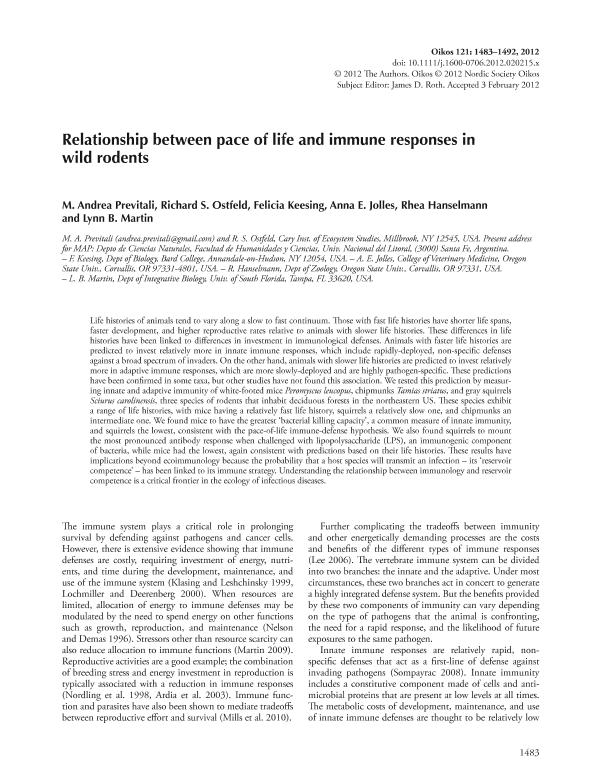Mostrar el registro sencillo del ítem
dc.contributor.author
Previtali, Maria Andrea

dc.contributor.author
Ostfeld, Richard S.
dc.contributor.author
Keesing, Felicia
dc.contributor.author
Jolles, Anna E.
dc.contributor.author
Hanselmann, Rhea
dc.contributor.author
Martin, Lynn B.
dc.date.available
2023-03-21T23:22:14Z
dc.date.issued
2012-09
dc.identifier.citation
Previtali, Maria Andrea; Ostfeld, Richard S.; Keesing, Felicia; Jolles, Anna E.; Hanselmann, Rhea; et al.; Relationship between pace of life and immune responses in wild rodents; Wiley Blackwell Publishing, Inc; Oikos; 121; 9; 9-2012; 1483-1492
dc.identifier.issn
0030-1299
dc.identifier.uri
http://hdl.handle.net/11336/191301
dc.description.abstract
Life histories of animals tend to vary along a slow to fast continuum. Those with fast life histories have shorter life spans, faster development, and higher reproductive rates relative to animals with slower life histories. These differences in life histories have been linked to differences in investment in immunological defenses. Animals with faster life histories are predicted to invest relatively more in innate immune responses, which include rapidly-deployed, non-specific defenses against a broad spectrum of invaders. On the other hand, animals with slower life histories are predicted to invest relatively more in adaptive immune responses, which are more slowly-deployed and are highly pathogen-specific. These predictions have been confirmed in some taxa, but other studies have not found this association. We tested this prediction by measuring innate and adaptive immunity of white-footed mice Peromyscus leucopus, chipmunks Tamias striatus, and gray squirrels Sciurus carolinensis, three species of rodents that inhabit deciduous forests in the northeastern US. These species exhibit a range of life histories, with mice having a relatively fast life history, squirrels a relatively slow one, and chipmunks an intermediate one. We found mice to have the greatest ‘bacterial killing capacity’, a common measure of innate immunity, and squirrels the lowest, consistent with the pace-of-life immune-defense hypothesis. We also found squirrels to mount the most pronounced antibody response when challenged with lipopolysaccharide (LPS), an immunogenic component of bacteria, while mice had the lowest, again consistent with predictions based on their life histories. These results have implications beyond ecoimmunology because the probability that a host species will transmit an infection – its ‘reservoir competence’ – has been linked to its immune strategy. Understanding the relationship between immunology and reservoir competence is a critical frontier in the ecology of infectious diseases.
dc.format
application/pdf
dc.language.iso
eng
dc.publisher
Wiley Blackwell Publishing, Inc

dc.rights
info:eu-repo/semantics/openAccess
dc.rights.uri
https://creativecommons.org/licenses/by-nc-sa/2.5/ar/
dc.subject
Ecoimmunology
dc.subject
Pace of life
dc.subject
Rodents
dc.subject
Immnune responses
dc.subject.classification
Ecología

dc.subject.classification
Ciencias Biológicas

dc.subject.classification
CIENCIAS NATURALES Y EXACTAS

dc.title
Relationship between pace of life and immune responses in wild rodents
dc.type
info:eu-repo/semantics/article
dc.type
info:ar-repo/semantics/artículo
dc.type
info:eu-repo/semantics/publishedVersion
dc.date.updated
2023-03-20T14:59:26Z
dc.journal.volume
121
dc.journal.number
9
dc.journal.pagination
1483-1492
dc.journal.pais
Suecia

dc.description.fil
Fil: Previtali, Maria Andrea. Ecosystem Studies; Estados Unidos. Consejo Nacional de Investigaciones Científicas y Técnicas; Argentina
dc.description.fil
Fil: Ostfeld, Richard S.. Ecosystem Studies; Estados Unidos
dc.description.fil
Fil: Keesing, Felicia. Ecosystem Studies; Estados Unidos
dc.description.fil
Fil: Jolles, Anna E.. Ecosystem Studies; Estados Unidos
dc.description.fil
Fil: Hanselmann, Rhea. Ecosystem Studies; Estados Unidos
dc.description.fil
Fil: Martin, Lynn B.. Ecosystem Studies; Estados Unidos
dc.journal.title
Oikos

dc.relation.alternativeid
info:eu-repo/semantics/altIdentifier/url/https://onlinelibrary.wiley.com/doi/10.1111/j.1600-0706.2012.020215.x
dc.relation.alternativeid
info:eu-repo/semantics/altIdentifier/doi/http://dx.doi.org/10.1111/j.1600-0706.2012.020215.x
Archivos asociados
